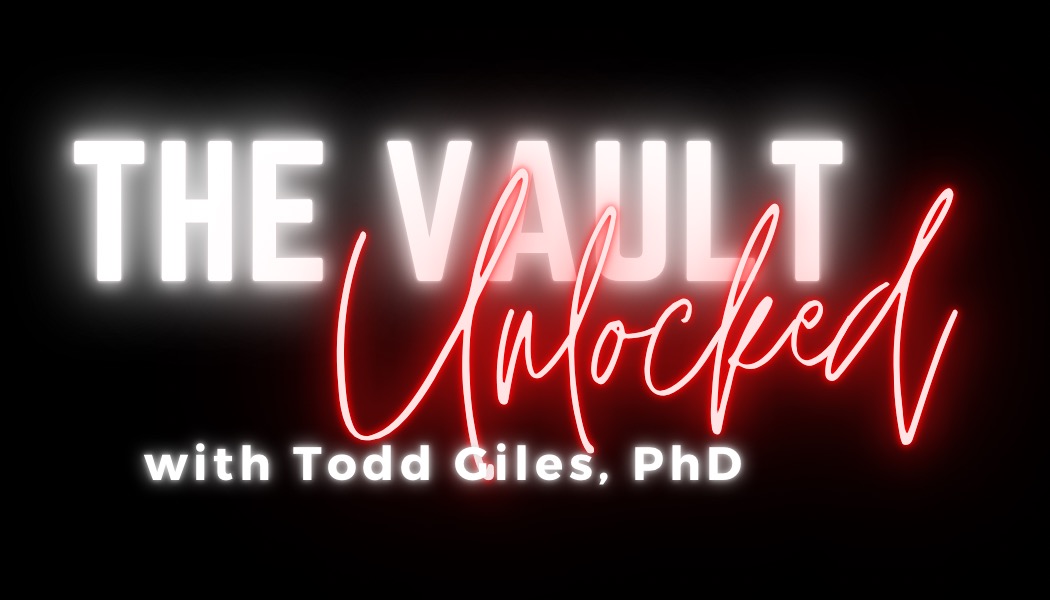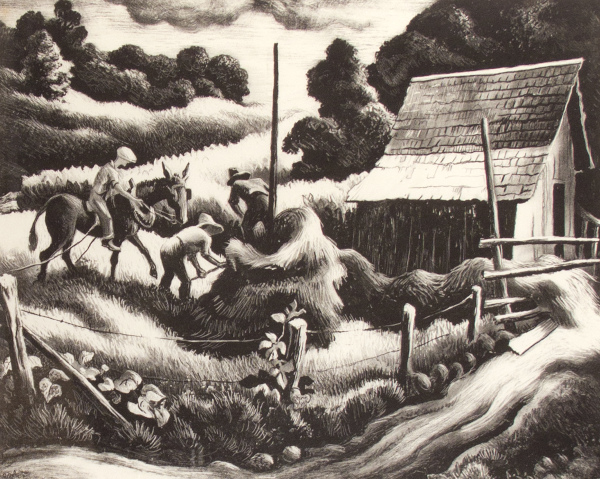
Ever wonder where the art is stored at the WFMA, and what's in there anyway? Join MSU professor Todd Giles as he unlocks the vault!

Thomas Hart Benton
Haystack, 1938
Lithograph
13 1/2 X 11 in.
Signed edition of 250
Published by Associated American Artists
Museum purchase assisted by the National Endowment for the Arts, 1975.
“No American art could be produced by an artist if he doesn’t live in an American way, if he doesn’t behave as an American, and if he does not find in America his reason to live”
~ Thomas Hart Benton
[Transcript]
Hello and welcome to The Vault Unlocked. My name is Todd Giles and we’re here to take you inside the collection vault at the Wichita Falls Museum of Art at MSU Texas. In this episode, we will take a close look at Thomas Hart Benton’s 1938 lithograph titled Haystack.
Thomas Hart Benton (1889–1975), whose art and writing epitomizes the early 20th century movement known as Regionalism, is invariably grouped together with two other Midwestern artists held in the WFMA’s permanent collection—Grant Wood and John Steuart Curry. All three artists believed that American culture and values were not to be found in the booming city centers of New York and Chicago, where most artists lived and worked at the time, but rather in small, rural farming communities. Theirs was not an avant-garde art depicting skyscrapers like that of John Marin and Charles Sheeler (both also represented in the WFMA), nor that showing the squalor of the metropolis’ downtrodden masses like Social Realists John Sloan and George Bellows (ditto); rather, Benton, Curry and Wood depicted the farmland of the breadbasket and all it entailed—bucolic country scenes, prairie families fleeing tornadoes, farmers at work, American folk heroes and, in Benton’s case, historical and folk narratives highlighting American industry and ingenuity. The Regionalists were, in short, like the American “return to the village” authors of the period, looking back nostalgically to earlier, less troubling times. Theirs was an art of rolling hills realism in a time of Cubist fragmentation and angularity, an art depicting an Edenic cornucopia of small family farmers in an America whose farmland had been devastatingly turned to dust.
Benton was born in Neosho, Missouri in 1889 during a period of unprecedented social and technological change. To refresh our historical memories, here are some important dates: 1869 (the completion of the transcontinental railroad); 1876 (the invention of the telephone); 1879 (the lightbulb); 1888 (the camera). In 1893, historian Fredrick Jackson Turner presented his “Frontier Thesis,” arguing that the frontier that had shaped the development and sprit of the nation was now closed. That is, Americans of European descent were no longer able to seek a “virgin” landscape to start afresh as the nation was now populated from East to West (Turner 8). 1895 (Marconi invents the wireless telegraph); 1902 (the Flat Iron building is built in New York City); 1903 (the Wright Brothers lift off); 1908 (Ford builds the Model T). And, of course, World War One was just around the corner to herald in even more massive changes.
This is the world Benton and his fellow Regionalists were born into. Some American artists who were influenced by the European Cubists, Futurists, Dadaists and Surrealists embraced these rapid changes; others tried to hold onto the past by looking backwards to some imagined agrarian ideal, advocating an art not “tainted” by European influences. Why not? Ralph Waldo Emerson and Walt Whitman both argued for the development of a thoroughly American artistic expression, only they did so not by looking back—in their case to the European poetic tradition—but rather by looking forward to a burgeoning American idiom to come. This has always been one of the great conundrums of American culture, this looking forward by (or not) looking backward to the European tradition.
As was the case with Grant Wood, most of Benton’s 90 lithographs were based on preexisting paintings and drawings. These works on paper did two things for Benton and other artists of the era—they helped put money in their Depression-depleted pockets, and they enabled average Americans to more easily purchase original works of art through magazine subscription services and organizations like Associated American Artists in New York City. Associated American Artists was run by Reeves Lewenthal, who, in 1934, got together with some twenty artists, including Benton, Curry and Wood, and proposed something quite novel—making prints available for purchase by selling lithographs to department stores and through mail order. Prior to this, prints were generally produced in small editions of 20 to 50, and were sold for around ten to fifty dollars each. Lewenthal’s artists printed editions of 250, which were sold for $5 each. Associated American Artists distributed fifty of Benton’s lithographs, including Haystack. All told, they sold around twelve thousand prints by Benton. It’s no wonder Benton was one of the most famous artists in America at the time. Not only did his art depict the average American, they themselves were able to afford it—at least those who had middle-class jobs during the Depression.
Lewenthal was a promoter and distributer; it was George Miller who printed nearly all of Benton’s lithographs. Miller was the top master printer in America from 1915 until his early death in 1966. Other artists held in the WFMA’s permanent collection who worked with Miller in his New York printmaking studio include Rockwell Kent, Arthur B. Davies, Grant Wood, Lionel Feininger, Reginald Marsh, Joseph Pennell, and Childe Hassam.
Benton’s lithograph Haystack found its genesis as a 1928 drawing he made of a North Carolina hill farm; ten years later, that drawing inspired Benton’s painting of the same name. That same year, Haystack was also produced as one of Lewenthal’s lithographs. Both works are thematically related to two similar oil paintings to come: Cradling Wheat (and its own attendant lithograph from 1938 and 1939, respectively), and July Hay(1943). Haystack has all the hallmarks of Benton at his best—representational (though stylized) depictions of everyday Americans, undulating (and stylized) natural landscapes, rural settings, and sympathetic depictions of manual laborers.
For Benton and his fellow Regionalists, the farmstead became an enduring American icon, speaking back to the Jeffersonian ideal of the yeoman farmer and later to the Emersonian ideal of self-reliance. Where the Regionalists faltered, though, is that they were not necessarily painting the reality of the world around them—disenfranchised tenement farmers, foreclosed farmsteads, breadlines, and a landscape utterly decimated by over-farming. No, theirs was an ideal depiction of the world; but perhaps that’s what the American public needed during the throws of the Great Depression and Dust Bowl—a nostalgia-inducing fantasy of days gone by. Theirs is an art that shows men and women working, rather than one that, like that of their Social Realist contemporaries, sets minds to working. Some artists and writers critique the contemporary realities of their world, whereas others turn their gaze to an idealized past. Both, through the lens of historical distance, are valuable markers for looking at the multitude of voices that make up our past and the present. Art worth its salt, however topical, is universal; the universal encompasses past, present, and future. And I’m not just making hay.
Thanks for joining us as we unlock the vault at the Wichita Falls Museum of Art at MSU Texas. To learn more about the WFMA our current and upcoming exhibitions, the permanent collection, as well as sign up for our e-newsletter, visit wfma.msutexas.edu.
Works Consulted
Adams, Clinton. American Lithographers, 1920s-1960s: The Artists and their Printers. U of New Mexico P, 1983.
Balker, Debra Bricker. After Many Springs: Regionalism, Modernism and the Midwest. Des Moines Art Center, 2009.
Davidson, Abraham A. Early American Modern Painting, 1910-1935. Harper & Row, 1981.
Goldman, Judith. American Prints: Process & Proofs. Harper & Row Publishers, 1982.
Fath, Creekmore. The Lithographs of Thomas Hart Benton. UT Press, 1969.
Fern, Alan and Ellen S. Jacobowitz, et al. American Graphics: Selected from the Collection of the Philadelphia Museum of Art. Philadelphia Museum of Art, 1982.
Koenhauser, Elizabeth Mankin. American Moderns on Paper: Masterworks from the Wadsworth Athenaeum Museum of Art. Yale UP, 2010.
Turner, Frederick Jackson. "The Significance of the Frontier in American History." 1893. www.usmcu.edu/Portals/218/Turner%20Thesis%2C%20Frederick%20Jackson%20Turner.pdf.
Watrous, James. A Century of American Printmaking, 1880-1980. U of Wisconsin P, 1984.
Haystack from the Permanent Collection of the Wichita Falls Museum of Art at MSU Texas
View Previous The Vault Unlocked
-
Tuesday - Friday
10:00AM - 5:00PMSaturday
1:00PM - 5:00PM